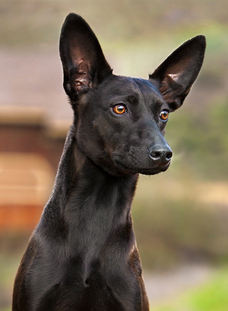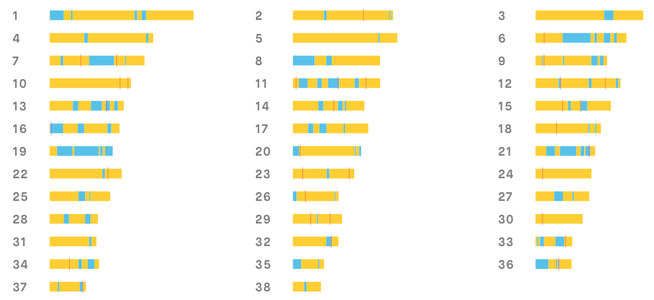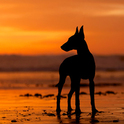| A paper just published (Nicholas et al. 2018) has expressed some reservations about the microsatellite test being used by Davis. The authors are highly qualified and well known canine geneticists, and their comments are specific and significant. Since they question the validity and appropriateness of the test to estimate relatedness and genetic variation in dogs, it is important for breeders that might use this test to understand the issues. Below I will summarize the concerns expressed in the paper by Nicholas et al., but first I will also review some information from a paper published in 2006 that also bears on the reliability of the test (Oliehoek et al., 2006). I have excerpted material directly from both papers so you can read the comments from these papers directly. If you get bored reading about the first issue, don't skip reading about the second one. It is just as important. |
The effectiveness of methods for estimating relatedness, including the method used by Davis, was examined in a paper by Oliehoek et al (2006). They looked at eight different algorithms, including the one used in the Davis test by Queller & Goodnight (1989), which they refer to as "Q&G". The Q&G estimator was originally designed to estimate relatedness between populations, but with a modification it can be used for pairwise comparisons of individuals.
Oliehoek et al. concluded that two of the algorithms they tested, UCS and Q&G (the one used by Davis), performed so poorly as to not merit further consideration. What is meant by "poorest results"? It means that their estimators of relationship deviated significantly from the true relationships, which were known because they used a simulated pedigree database. They felt that the errors were so consequential that they didn't proceed with further testing of these two algorithms.
A paper has just been published that is critical of the Davis diversity test (Nicholas et al. 2018) as used in a study of Samoyeds (Pedersen et al. 2017).
Their complaints:
1) "using a small number (33) of microsatellite markers that cover only 66% (25/38) of autosomes is suboptimal for determining genetic variation occurring across the genome"; and
2) "the sample of dogs from which "breed-wide genetic diversity" was estimated contained a substantial but undisclosed number of close relatives (and so was not a random sample nor representative of the wider breed, meaning that the findings pertaining to genetic variation cannot safely be extrapolated without qualification."
The second criticism is specific to the population of Samoyed used in that particular study. The first, however, is about the method itself and would apply to all breeds using the test. Specifically, they are suggesting that it cannot be assumed that the genetic variation determined from a small number of markers on only 25 of 38 autosomes is representative of whole genome diversity.
They go on to say:
| "The study used microsatellite markers to estimate the genetic diversity of the Samoyed breed. While microsatellites have previously been used to this, they have largely been superseded by dense SNP chips, where the quantity of bi-allelic marker data provides more precise information on the extent of genetic variation via homozygosity. The study used 33 short tandem repeats (STRs) on 25 autosomes, which is an average of 1.32 STRs per autosome included. However, since Canis familiaris has 38 autosomes, there was no means in this study to determine genetic variation across 1/3 of the genome. It is highly likely that there is genetic variation present within the Samoyed breed on these 13 autosomes, but this study is simply unable to detect its extent. Furthermore, genetic variation at genomic regions on the 25 included autosomes not in linkage disequilibrium with the STRs also cannot be detected. Thus, while this number of STRs may be sufficient for their stated purpose (parentage verification and forensic testing) and an acceptable "broad brush" means of estimating diversity in a population where there is no alternative (such as wild populations), they are unable adequately to describe the extent of genetic variation across the canine genome, including regions of depleted variation due to selection." |
| "Professors Nicholas and Mellersh and Dr Lewis were concerned about the methodology that led us to conclude that Samoyed lack genetic diversity... Their first criticism involved the use of 33 microsatellites markers across only 25/38 autosomes. This was linked to another question pertaining to why microsatellites were even being used at all, given modern SNP technology. The microsatellites chosen for this study were vigorously selected for their ability to discern genetic differences by the International Society for Animal Genetics, with addition of several new markers from our Veterinary Genetics Laboratory. The microsatellites are known to be highly polymorphic and have been used successfully for many studies concerning parentage and genetic diversity. Some of the added markers were for the DLA class I and II regions, which contains genes concerned with immune responses. This region is in strong linkage disequilibrium, with one copy inherited by descent from each parent. It is extremely difficult to define the DLA region using SNPs due to the numerous polymorphisms, but it is very efficient and accurate to track this region using microsatellites. DLA haplotypes are powerful identifiers of breed founders. We were also concerned about the fact that our markers did not cover every chromosome and added 25 more microsatellites to cover missing chromosomes. We found that the additional microsatellites, although carefully selected, did not add anything to the power of the current 33 markers to study breed-wide genetic diversity and relatedness. We also compared genetic diversity in Standard Poodles by both microsatellites and 170K SNPs and found no major differences... We are confident, therefore, that the genetic diversity we were measuring in Samoyed was accurate as described and that employing large panels of SNPs would not significantly alter the conclusions." |
The problem I suspect Nicholas et al. will have with this is that there is no information provided that directly addresses their concerns about the measurement of genetic variation. Much of the response was about the markers for DLA and was not relevant to the estimation of autosomal genetic variation. Assurances were offered that, in unpublished experiments they did, the addition of 25 microsatellites "did not add anything to the power of the current 33 markers". Further, a comparison of diversity measured with the microsatellite panel and 170K SNPs "found no major differences". However, no data are provided to support either of these statements. It would have been appropriate and useful for them to provide the data and analyses behind these statements, but unfortunately they do not.
The reason the methods and results of research are provided in such detail when published is to support the claims made about the data to the satisfaction of other scientists. Here, we're supposed to just "take their word for it". I think many scientists would be concerned about doing this.
Where does that leave us? Breeders have to assume that information provided to them by science professionals is "true". Davis is arguably the best vet school in the country, and they have a stellar group of veterinary and population geneticists with much expertise and sound reputations. I would go to them for advice or information and I have. But on this one thing, I have to agree with my scientific colleagues: the information provided by the Davis test is likely flawed and should not be used by breeders unless it can be proven otherwise.
The fix for the problems with the method used to calculate internal relatedness could be simple. Redo the calculations using the equation that performed best in the simulations by Oliehoek et al. Davis could do this, or the dog owners could provide their data to somebody carefully chosen to have the appropriate expertise for reanalysis, preferably one of the authors (e.g., Pieter Oliehoek).
The issue with the reliability of the test because it uses too few markers is more difficult to remedy and just as serious. This test is the basis for several published studies, and there is a growing list of breeds that are using it for assessment of genetic variation and relatedness in making breeding decisions.
Breeders need to be aware of these issues. There is no more serious concern about a method than that the data produced are not reliable. There are other test options available that use SNPs, and for breeders that must also do trait or mutation testing those are probably more cost effective. SNPs are rapidly replacing STRs in many applications, and there is considerable value in having data from today's dogs that will be compatible with data for future generations. Breeders should carefully assess what information they need, now and in the future, and select the test option that best suits these requirements.
The layperson might be horrified to read the critical comments about a scientific study from other scientists. Be assured that this is the normal process of science. A scientist can expect every word that comes out of their mouth for their entire career to be scrutinized, assessed, and criticized by their colleagues. The criticism will be direct but never personal. In fact, it could be said that scientists sit around picking away at the work of their colleagues for mental sport. It is interesting, stimulating, even fun, and it often results in useful insights that advance a project or field. It is not "bashing", "slamming", or any of the other many terms I have heard used by dog breeders in these contexts. Indeed, I have never heard these terms used by scientists about each other; they simply are not appropriate because they imply that the comments are unfair, inappropriate, and personal, when they are not. Scientists disagree with each other all the time. It's the normal warp and woof of science.
By way of an example, my own favorite criticism was directed to me by the editor of a journal to which I had sent a manuscript for review very early in my career. Although the reviews were favorable, the editor (whom I knew) told me that he didn't like the statistics I had used and suggested that were he to publish the paper, I would "come to find it an embarrassment" later in my career. I sent the paper to another (better!) journal, which published it. It was well-received, and I have never been embarrassed about it. The editor and I remained friends and colleagues.
REFERENCES
Nicholas FW, C Mellersh, & T Lewis 2018. Letter to the editor regarding an autosomal recessive mutation in SCL24A4 causing enamel hypoplasia in Samoyed and its relationship to breed-wide genetic diversity. Canine Genetics and Epidemiology 5: 4. DOI 10.1186/s40575-018-0059-7
Oliehoek PA, JJ Windig, JAM van Arendonk, & P Bijma. 2006. Estimating relatedness between individuals in general populations wiht a focus on their use in conservation programs. Genetics 173: 483-496.
Pedersen NC, B Shope, and H Liu. 2017. An autosomal recessive mutation in SCL24A4 causing enamel hypoplasia in Samoyed and its relationship to breed-wide genetic diversity. Canine Genetics and Epidemiology 4:11. DOI 10.1186/s40575-017-0049-1
Pedersen NC, B Shope, and H Liu. 2018. Letter to the editor regarding an autosomal recessive mutation in SCL24A5 causing enamel hypoplasia in Samoyed and its relationship to breed-wide genetic diversity. Authors' response. Canine Genetics and Epidemiology 5: 4. DOI 10.1186/s40575-018-0059-7
ICB's online courses
***************************************
Visit our Facebook Groups
ICB Institute of Canine Biology
...the latest canine news and research
ICB Breeding for the Future
...the science of animal breeding




